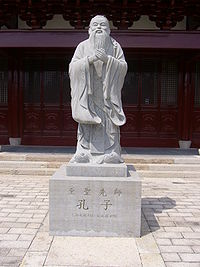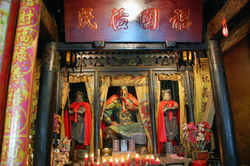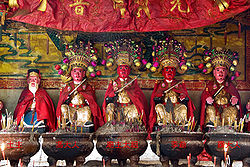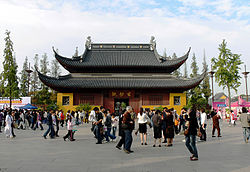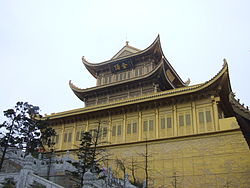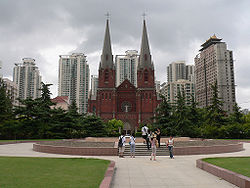- Religion in China
-
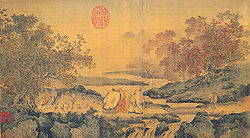 "Three laughs at Tiger Brook", Confucianism, Taoism, and Buddhism are one, a litang style painting portraying three men laughing by a river stream, 12th century, Song Dynasty.
"Three laughs at Tiger Brook", Confucianism, Taoism, and Buddhism are one, a litang style painting portraying three men laughing by a river stream, 12th century, Song Dynasty.
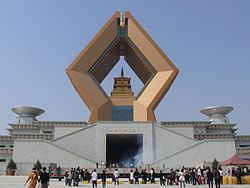 The imposing stupa enshrining the relic of Shakyamuni Buddha's finger bone, at Famen Temple, a Buddhist complex in Baoji, Shaanxi.
The imposing stupa enshrining the relic of Shakyamuni Buddha's finger bone, at Famen Temple, a Buddhist complex in Baoji, Shaanxi.
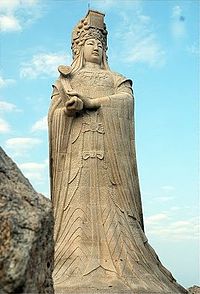 Statue of Mazu in Meizhou Island, Fujian. Mazu is perhaps the most popular goddess in Southern Chinese provinces and Taiwan.
Statue of Mazu in Meizhou Island, Fujian. Mazu is perhaps the most popular goddess in Southern Chinese provinces and Taiwan.
Religion in China has been characterized by pluralism since the beginning of Chinese history. The Chinese religions are family-oriented and do not demand the exclusive adherence of members. Some scholars doubt the use of the term "religion" in reference to Buddhism and Taoism, and suggest "cultural practices" or "thought systems" as more appropriate names.[1] The questions of what should be called religion or religious in China, and who should be called religious is up to debate.[2] Generally, the percentage of people who call themselves religious in China has been among the lowest in the world.
Buddhism remains a main popular religion in China since its introduction in the 1st century; the largest group of religious traditions is however that of Chinese folk religion or "Shenism", a term coined by A.J. Elliot,[3] which he used to collectively name Chinese folk religions, as the ethnic religion of the Hans, which encompasses Taoism, and the worship of the shens, a collection of various local ethnic deities, heroes and ancestors, and figures from Chinese mythology, among which the most popular ones in recent years have been Mazu (goddess of the seas, patron of Southern China), Huangdi (divine patriarch of all the Chinese, "Volksgeist" of the Chinese nation),[4][5][6] the Black Dragon,[7][8][9] Caishen (god of prosperity and richness),[10] and others.
Although an established presence since the 7th century, Christianity in China declined as a result of persecution during the 10th through 14th centuries.[citation needed] It was reintroduced in the 16th century by Jesuit missionaries.[citation needed] In the 18th and 19th centuries, with the widespread influx of European ideology into China, Western religions gained a foothold, notably causing the Taiping Rebellion. While the Communist Party of China came to power in 1949, it was regarded as an atheist faction which viewed traditional religions as backwards, and Western religions such as Christianity as the tool of Western colonialism, and has steadfastly maintained separation of church from state affairs[11] in order to prevent recurrence of situations like the Taiping Rebellion. After the "opening up" of the 1980s, more religious freedoms were granted,[citation needed] and traditional beliefs like Taoism and Buddhism were supported as an integral part of the Chinese culture.
Nowadays Shenism-Taoism and Buddhism are the largest religions in China with respectively over 30%[12][13][14] (of which 160 million, or 11% of the total population of the country, are Mazuists[15]) and 18–20%[16][17][18] of the population adhering to them, thriving throughout the country as the government is allowing them to spread.[19] Almost 10% of the population is composed of those regarded as non-Han ethnicities who following their traditional tribal religions.[20][21] Christians are 3–4% of the population according to various detailed surveys,[22][23][24][25] although American press states there might be more due to the house church movement;[26] Muslims are 1–2%.[27] However, the biggest part of the population, ranging between 60% and 70%, is mostly agnostic or non-religious; purely atheists .[24][28][29] Various new religious movements, both indigenous and exogenous, are scattered across the country.[30] Confucianism as a religion is popular among intellectuals.[31]
China has many of the world's highest statues, and even the highest absolute one amongst all. Most of them represent buddhas, deities and religious personalities and have been built in the 2000s. The world's tallest statue is the Spring Temple Buddha, located in Henan. Recently built in the country are also the world's tallest pagoda[32] and the world's tallest stupa.[33]
Contents
Ancient and Pre-historic
Prior to the advent of Chinese civilization and World religion in the region generally known today as East Asia including the territorial boundaries of modern-day China; tribal or primal religious practices were the way in which prayers, sacrifices or offerings were communicated to the spiritual world by groups or mediatory individuals such as shamans.[34] Following the dawn of Chinese civilization, an early indigenous form of religious practice in Chinese history began to develop from the more primitive elements of animism, folk religions and Shamanism; known as Taoism,[35] and is considered a Traditional Chinese Religion along with Confucianism and other Chinese folk religions with a constituency of almost 400 million followers in China alone. Animism in China and Shamanism which has the longest recorded history in China,[36] is still practiced formally by numerous ethnic groups around China, including the Han Chinese, but whose historic text and literature usually neglect this religious aspect of the Han people's history.[37][38][39][40][41][42]
Modern history
See also: State atheismThe People's Republic of China was established October 1, 1949. Its government is officially atheist, having viewed religion as emblematic of feudalism and foreign colonialism, and maintained separation of state and the church. This changed during the Cultural Revolution, in 1966 and 1967. The Cultural Revolution led to a policy of elimination of religions; a massive number of places of worship were destroyed.[43]
This policy relaxed considerably in the late 1970s at the end of the Cultural Revolution and more tolerance of religious expression has been permitted since the 1980s. The 1978 Constitution of the People's Republic of China guarantees "freedom of religion" in Article 46. The policy regarding religious practice in China states that "No state organ, public organization or individual may compel citizens to believe in, or not to believe in, any religion; nor may they discriminate against citizens because they do, or do not believe in religion. The state protects normal religious activities", and continues with the statement that: "nobody can make use of religion to engage in activities that disrupt social order, impair the health of citizens or interfere with the educational system of the state."[44] Since the mid-1980s there has been a massive program to rebuild Buddhist and Taoist temples. In recent times, the government has expressed support for Buddhism and Taoism, organizing the World Buddhist Forum in 2006 and the International Forum on the Daodejing in 2007. The government sees these religions as an integral part of Chinese culture.[45]
There are five recognized religions by the state, namely Buddhism, Taoism, Islam, Catholicism, and Protestantism.[46] To some degree, the government also controls the institutions in the religions it recognizes.[47] In October 2007, the new statute of China cites religion as an important element of citizens' life.[48] However, the Chinese government has also banned certain new religious movements.
Temple economy
Scholars have studied how Chinese folk religion-based society, elastic and polytheistic in spirit, provided the groundwork for the development of dynamic grassroots capitalism with Chinese characteristics in Song Dynasty China and modern capitalism in contemporary Taiwan.[49][50][51][52] The revival of Chinese folk religion with its ritual economy or temple economy, studied by on-ground researches,[53] is also the key of the contemporary economic development in rural Mainland China.[54][55]
Demographics
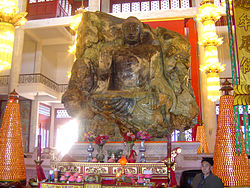 Anshan Jade Buddha, the largest jade statue in the world, in the interior of Jade Buddha Temple in Anshan City, Liaoning.
Anshan Jade Buddha, the largest jade statue in the world, in the interior of Jade Buddha Temple in Anshan City, Liaoning.
 A variety of Chinese priests and monks seen by Johan Nieuhof between 1655 and 1658.
A variety of Chinese priests and monks seen by Johan Nieuhof between 1655 and 1658.
Chinese Buddhists are evenly distributed across the whole country. Southern provinces are the stronghold of ethno-national Han Shenism thickly mingled with Zhengyi "Southern" Taoism. Chinese folk religion can also be found up through central provinces until it becomes sparse in the north-eastern zones (where Beijing is situated), which are largely secularized, the vast majority of their population being atheist and agnostic with significant proportions of Buddhists and Quanzhen "Northern" Taoists.
Sichuan is a stronghold of Taoism in its various brands, covering the area where Tianshi Taoism developed and the Celestial Masters had their main seat. Christians are mostly concentrated in easternmost provinces and coastal areas, particularly in Zhejiang, Anhui, and generally in the Wu-speaking zone, curiously the areas which were most affected by the Taiping regime. Tibetan Buddhism is the dominant religion in Tibet, other westernmost provinces where ethnic Tibetans constitute a significant amount of the population, and Inner Mongolia in the north; it is also having a growing influence among ethnic Hans.[56][57] Islam is the majority religion in the ethnic Hui areas, particularly Ningxia, and in the Uyghur province of Xinjiang. Many non-Han minority ethnic groups follow their own traditional ethnic religions (for example, Dongbaism). Confucianism as a religion is popular among intellectuals.[31]
A great diversity of new religious movements are thriving across China.[58] The majority are indigenous, and into this group some are totally new whilst others were already active before the communist revolution in 1949, and are being re-introduced from Taiwan. The most relevant among these last are Yiguandao (and other sects within the Xiantianism category),[59] Tiendery-Tientism,[60] Yaochidao and Zailiism;[30] among the very new ones the most notable are the various Qigong-inspired groups, such as Falun Gong, Zhong Gong, Yuanji Gong and Wang Gong, and Christian-inspired Taiping-style sects such as Zhushenism, Linglingism, Fuhuodao, Mentuhui and Lightning from the East.[61][62] Other movements are allogenous in origin, for example the Bahá'í Faith.[63] All these movements are not recognised by the government, and most of them are regarded as cults; some are also banned and harshly repressed.[64]
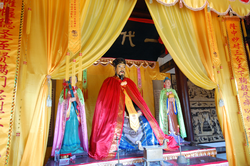 Altar to Zhuge Liang inside an ancestral temple in his hometown Yinan, Shandong.
Altar to Zhuge Liang inside an ancestral temple in his hometown Yinan, Shandong.
 Modern-style Buddhist temple in Qibao, Shanghai.
Modern-style Buddhist temple in Qibao, Shanghai.
Statistics
Communist governments often suppress religious freedom and officially (often forcibly) endorse atheism. Due to this the relation between the Government and religions was not smooth in the past.[29] In recent years, the Chinese government has opened up to religion, especially traditional religions such as Mahayana Buddhism, Taoism and Shenism because the Government also continued to emphasize the role of religion in building a "Harmonious Society," which was a positive development with regard to the Government's respect for religious freedom.[65]
According to an old Chinese government estimate, there were "over 100 million followers of various faiths" in China.[66] Other estimates put about 100 million or about 8% Chinese who follow Buddhism, with the second largest religion as Taoism (no data), Islam (19 million or 1.5%) and Christianity (14 million or 1%; 4 million Roman Catholics and 10 million Protestants).[67] According to the 1993 edition of The Atlas of Religion, the number of atheists in China is between 10 and 14 percent.[68]
The accuracy of the religious data in China from census sources is questionable. While official data estimated 100 million religious believers in China, a survey taken by Shanghai University found that 31.4% of people above the age of 16, or about 300 million people, considered themselves religious. The survey also found that the major religions are Buddhism, Taoism, Islam and Christianity, accounting for 67.4 percent of believers. About 200 million people are Buddhists, Taoists or worshippers of legendary figures such as the Dragon King and God of Fortune, accounting for 66.1 per cent of all believers, while Christianity accounted for 12% of believers, or 40 million people.[69][70] The official China Daily called the Shanghai professors' research "the country's first major survey on religious beliefs".[71] The Chinese government have accepted these new numbers. The wide disparity among these estimates underscores the difficulty of accurately surveying the religious view of a nation of over a billion people and the lack of reliable data.
Average data from various surveys put the total number of Chinese Buddhists at a growing 18% to 20% of the total population, or around 300 million people.[16][17][18] However, some estimates suggest that the cultural adherents or even outright religious adherents of Buddhism could number as high as 50%, or about 660 million.[72][73] Estimates for Shenism and Taoism put their intermingled membership at 300 to 400 million, or 20% to 30% of the total population.[13][74]
The number of adherents of Buddhism and Chinese ethnic religions can also be overlaid in percentage because many Chinese consider themselves both Buddhist and Shenist-Taoist.[75][76][77][78][79] The minority religions are Christianity (between 40 million, 3%,[22] and 54 million, 4%[23]), Islam (20–30 million, 1.5%–2%), the traditional tribal religions of the non-Han ethnic groups (Moz, White Stone Religion, Dongbaism, Bön),[21] Judaism, Hinduism, and a number of new religions and sects (particularly Xiantianism and Falun Gong).
According to the surveys of Phil Zuckerman on Adherents.com in 1993; there was 59% (over 700 million)[28] of the Chinese population was irreligious and 8% – 14% was atheist (from over 100 to 180 million) as of 2005.[29] There are intrinsic logistical difficulties in trying to count the number of religious people anywhere, as well as difficulties peculiar to China. According to Phil Zuckerman, "low response rates," "non-random samples," and "adverse political/cultural climates" are all persistent problems in establishing accurate numbers of religious believers in a given locality.[80] Similar difficulties arise in attempting to subdivide religious people into sects. These issues are especially pertinent in China for two reasons. First, it is a matter of current debate whether some several important belief systems in China constitute "religions." As Daniel L. Overmeyer writes, in recent years there has been a "new appreciation...of the religious dimensions of Confucianism, both in its ritual activities and in the inward search for an ultimate source of moral order".[81] Many Chinese belief systems have concepts of a sacred and sometimes spiritual natural world yet do not always invoke a concept of personal god (with the exception of Heaven worship).[82]
In 2010, according to an official survey conducted by the Chinese Academy of Social Sciences and published in the 2010 Bluebook Annual Report on China's Religions, the number of Protestants in China is 23.05 million, or 1.8% of the total population.[83][84][85] At the same time, a survey conducted by sociologist Fenggang Yang (specialised in the study of religion in Chinese societies) and the Purdue's Center on Religion and Chinese Society, revealed that 18% of the Chinese are Buddhist, 15% are non-religious and 3.2% are Christian.[24] These statistics are fairly similar to those reported by the 2008 Pew Forum survey.[25]
Cultural background
Confucius mores and morals
Main article: ConfucianismThe mores background of the Chinese people is deeply shaped by the Confucian philosophy (儒家; Rujia). Confucius' thought stresses ethical, moral and social values. This system of values is sometimes considered as the proper culture of the Chinese; consequently, for centuries it has targeted religious tendencies. According to the Confucian thought every culture should carry on its own primordial ethnic religion, which two main aspects are reverence for nature and for the ancient fathers; in the case of the Chinese it is the Chinese folk religion and Taoism compound, which pivotal element is the worship of ancestor gods. Confucianism arose during the 5th century BCE from the teachings of Confucius, collected under the name of the Analects. The Han Dynasty eventually made Confucianism the official state culture, along with Taoism which was the official religion.
Confucian social and political system remained established until 1912, when it was rejected by the new Republic of China and subsequently by the People's Republic of China. Since the 2000s[86] Confucianism have been experiencing a great revival in China, as it is supported by the central government. The People's Republic of China is establishing institutes for Confucian education all over the world.[86] The headquarter of all Confucius Institutes around the world locates in Beijing.[87] China has established 300 of such institutes as of 2010.[88] With the recent rise of nationalism and cultural conservatism among Chinese intellectuals, a growing number of them are converting to Confucianism and working to make it an institutional religion (see the relative section).[89]
Veneration of Ancestors
Main article: Ancestor veneration in ChinaChinese veneration of ancestors (拜祖, baizu; or 敬祖, jingzu) dates back to the prehistory and is considered an integrant part of Chinese folk religion, and a mandatory practice in Confucianism. Chinese culture and religions all value filial piety as a top virtue and De, and the act is a continued display of piety and respect towards departed ancestors. The veneration of ancestors can even extend to legendary figures or historical, such as the founder of one's Chinese surname, virtuous individuals such as Confucius or Guan Yu, or the mythological figures like Huangdi, the Yellow Emperor, considered the patriarch of all Han Chinese.
The two major festivals involving ancestor veneration are the Qingming Festival and the Double Ninth Festival, but veneration of ancestors is conducted in many other ceremonies, including weddings, funerals, and triad initiations. Worshipers generally offer prayers in a Jingxiang rite, with food, light incense and candles, and burn offerings of joss paper. These activities are typically conducted at the site of ancestral graves or tombs, at an ancestral temple, or at a household shrine.
Notable religions
Chinese ethnic religion
Main article: Chinese folk religionChinese folk religion (simplified Chinese: 中国民间宗教 or 中国民间信仰, pinyin: Zhongguo minjian zongjiao or Zhongguo minjian xinyang) or Shenism (Shenjiao, 神教)[90][91][92] are labels used to describe the collection of ethnic religious traditions which have been the majority belief system in China and among Han Chinese ethnic groups for the most part of the civilization's history till today. Shenism comprises Chinese mythology and includes the worship of shens (神, shén; "deities", "spirits", "awarenesses", "consciousnesses", "archetypes") which can be nature deities, clan deities, city deities, national deities, cultural heroes and demigods, dragons and ancestors.
It is sometimes considered a brand of Taoism, a Folk Taoism, since over the centuries institutional Taoism has been attempting to assimilate or administrate local religions; actually and more accurately Taoism can be defined as a branch of Shenism, since it sprang out of folk religion and Chinese philosophy. Chinese folk religion is sometimes seen as a constituent part of Chinese traditional religion, but more often, the two are regarded as synonymous. Unlike Taoism, the religious aspects found in Confucianism (worship of Confucius and his disciples, worship of Tian, rituals and sacrifices) never took independence form and have thus remained for centuries part of Shenism.
With around 400 million adherents Chinese folk religion is one of the major religions in the world, comprising about 6% of world population.[12][14] In China over 30% of the population adheres to Shenism or Taoism.[13]
Despite being heavily suppressed during the last two centuries of the history of China, from the Taiping Movement to the Cultural Revolution, it is now experiencing a revival[93][94] and is supported by the Government of the People's Republic of China, particularly in the forms of Mazuism in southern China (officially, about 160 million Chinese are Mazuists),[15] Huangdi worship,[4][5][6] Black Dragon worship in Shaanxi,[7][8][9] and Caishen worship.[10]
Scholars have studied how Chinese folk religion-inspired society, elastic and polytheistic in spirit, provided the groundwork for the development of dynamic grassroots Chinese-style pre-modern capitalism in Song Dynasty China and modern capitalism in contemporary Taiwan.[49][50][51][52] Chinese folk religion with its ritual economy is also the key of the contemporary economic development in rural Mainland China.[54][55]
Religious Confucianism
Religious Confucianism (儒教 Rujiao, "Religion of the Scholars"; or 孔教 Kongjiao, "Religion of Confucius") is a relatively new and still numerically small phenomenon, limited to the Chinese intelligentsia. Nevertheless, being well embedded in the Chinese academia, in recent years it has become very influential.
Whether Confucianism is a religion or not has been debated for more than one hundred years.[89] Religious aspects promoted by Confucianism include the establishment of temples for ancestral worship of Confucius and his disciples, knowledge and worship of Tian, ritual and sacrifice; however, over the centuries Confucianism never developed an official institutional structure as Taoism did, and its religious aspects never completely detached from Chinese folk religion.
Since 2003 the debate seems to have taken a turn.[89] Large numbers of intellectuals and students are converting to Confucianism,[89] making it a strong intellectual force.[31] A more and more influent movement among them is working to turn Confucianism into a religion (and a movement of its own, independent from the Chinese folk religion), to obtain recognisation by the Chinese government, and even make Confucianism the official state religion of China. Scholar Fenggang Yang calls this movement Confucian Fundamentalism.[89]
In 2003 the Confucian intellectual Kang Xiaoguang published a cultural nationalist manifesto in which he made four suggestions: Confucian education must enter official education at any level, from elementary to high school; the state must establish Confucianism as the state religion by law; Confucian religion must enter the daily life of ordinary people through standardization and development of doctrines, rituals, organisations, churches and activity sites; the Confucian religion must be spread through NGOs.[89]
All the suggestions appear to be being gradually implemented. Since the Jiashen Manifesto published in 2004, intellectuals are calling for a return to the Chinese traditional culture. The Government has since then supported the revival of the Chinese traditional religions, holidays and celebrations. In 2005 the Center for the Study of Confucian Religion was established, and scholars who criticised Confucianism as a religion lost their influence.[89] Also in 2005 Guoxue education started to be implemented in schools of any level. Being well received by the population, even Confucian "televangelists" started to appear on television since 2006.[89]
The most enthusiast and cultural nationalist and conservatist Confucian Fundamentalists proclaim the uniqueness and superiority of Confucian Chinese culture, and have generated some popular sentiment against Western cultural influences in China.[89] In January 2011 a statue of Confucius was unveiled on Tiananmen Square.[95][96]
Taoism
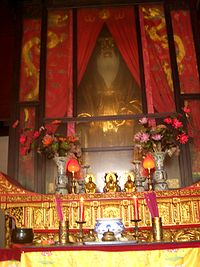 Altar to Laozi as Daode Tianjun ("Lord of the Way and the Virtue") and the Three Pure Ones at Changchun Temple, Wuhan, Hubei.
Altar to Laozi as Daode Tianjun ("Lord of the Way and the Virtue") and the Three Pure Ones at Changchun Temple, Wuhan, Hubei. See also: Chinese Taoist Association
See also: Chinese Taoist AssociationTaoism (道教; Daojiao in Chinese) refers to a variety of related philosophical and religious traditions and concepts, born in China itself in the 6th century BCE and it's traditionally traced to the composition of the Tao Te Ching attributed to the sage Laozi, a person who subsequently came to be venerated by Taoist as Daode Tianjun in the Three Pure Ones. Taoist thought focuses on health, longevity, immortality, wu wei (non-action) and spontaneity. These traditions have influenced East Asia for over two thousand years and some have spread internationally.[97]
Reverence for nature and ancestor spirits is common in popular Taoism. Organized Taoism distinguishes its ritual activity from that of the folk religion, which some professional Taoists (Daoshi) view as debased. Chinese alchemy, astrology, cuisine, several Chinese martial arts, Chinese traditional medicine, fengshui, and many styles of qigong breath training disciplines are intertwined with Taoism throughout history.
Taoism was established as a religion in the late Eastern Han Dynasty (25–220). During the Northern and Southern Dynasties (386–589), Neo-Taoism adopted concepts and methods from its rival, Buddhism. Some emperors supported it for political reasons while many educated men and women were attracted by its beauty and power. Taoism experienced its silver age from the Tang Dynasty (618–907) to the Northern Song Dynasty (960–1127). Many sects arose during this period. Taoist temples and Taoist masters spread throughout China. After the Yuan Dynasty (1271–1368), Taoism divided into two main sects: Quanzhen and Zhengyi Dao.[98]
Taoism gradually developed with the support of the rulers. However, during the Ming Dynasty (1368–1644), national conflicts sapped the energy and support for Taoism. In the Qing Dynasty (1644–1911), the Manchu rulers adopted Tibetan Buddhism and lost interest in Taoism.[98] After 1949, The People's Republic of China found Taoism detrimental to socialist reconstruction while permitting some practical arts linked to Taoism, such as the use of traditional herbal medicines.[99] In 1956 a national organization, the Chinese Taoist Association (with chapters in every province and city) was set up to administer Taoist activities.
Banned during the Cultural Revolution (along with all other religions), Taoism is undergoing a major revival today.[100] Both the Beijing Taoist Association and the Shanghai Taoist Association (local chapters of the Chinese Taoist Association) report their own membership to number over 100 million individuals.[101] Shenism, which includes Taoism, is estimated to be the largest religion in China with 20–30%[12][14] of the total population worshiping Shenist ethnic deities or adhering to Taoist institutions.
In April 2007, China took place the International Forum on the Daodejing, during which celebrities and government officials expressed will to support Taoism as one of the foundations of Chinese culture.[102] Chinese Taoist clergy is organizing missionary systems to spread the spirituality around the world.[100][103]
Buddhism
Golden Temple at the summit of Emei Shan, in Sichuan. Emei Shan is one of the Four Sacred Mountains of Chinese Buddhism.
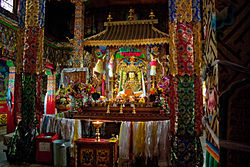 Altar inside Litang Monastery, a Tibetan Buddhist complex in Tibet.
Altar inside Litang Monastery, a Tibetan Buddhist complex in Tibet. Main articles: Chinese Buddhism, Buddhism in Tibet, and Chinese Buddhist AssociationSee also: East Asian Buddhism and Buddhism and Eastern religions
Main articles: Chinese Buddhism, Buddhism in Tibet, and Chinese Buddhist AssociationSee also: East Asian Buddhism and Buddhism and Eastern religionsBuddhism (called 佛教, Fojiao) was introduced from India during the Han Dynasty, traditionally in the 1st century. It became very popular among Chinese of all walks of life, admired by commoners, and sponsored by emperors in certain dynasties. It is estimated that by the 9th century Buddhist institutions had become the most powerful of China, surpassing the Taoist ones and challenging the authority of the government.
This led to the so called Great Anti-Buddhist Persecution, which saw Buddhism repressed. Although the persecution was heavy, Buddhism survived and reflourished in the following centuries. It experienced important developments at the time of some Chinese dynasties, such as Southern and Northern Dynasties, Sui Dynasty, Tang Dynasty, Song Dynasty, and others. Buddhism is deeply embedded in the culture of China, Chinese philosophy, and in Chinese pop culture today.
The entry of Buddhism into China was marked by interaction and syncretism with Taoism in particular.[104] Originally seen as a kind of "foreign Taoism", Buddhism's scriptures were translated into Chinese using the Taoist vocabulary.[105] Chan Buddhism was particularly shaped by Taoism, integrating distrust of scripture, text and even language, as well as the Taoist views of embracing "this life", dedicated practice and the "every-moment".[106] In the Tang period Taoism incorporated such Buddhist elements as monasteries, vegetarianism, prohibition of alcohol, the doctrine of emptiness, and collecting scripture into tripartite organisation. During the same time, Chan Buddhism grew to become the largest sect in Chinese Buddhism.[107]
Buddhism was not universally welcomed, particularly among the gentry. The Buddha's Dharma seemed alien and amoral to conservative and Confucian sensibilities.[108] Confucianism promoted social stability, order, strong families, and practical living, and Chinese officials questioned how a monk's monasticism and personal attainment of nirvana benefited the empire.[105] However, Buddhism and Confucianism eventually reconciled after centuries of conflict and assimilation.[109]
With the rise of People's Republic of China in 1949 Buddhism was banned and many temples and monasteries destroyed. Restrictions lasted until the 1980s. The Buddhist Association of China was founded in 1953. In recent times, Buddhism has recovered popularity and it is returned to be the largest organized faith in the country. While estimates of the number of Buddhists in China range widely, Chinese government statistics estimates the number of Buddhists at 100 million.[110]
Today the most popular form of Buddhism in China is a mix of the Pure Land and Chán schools. The most recent surveys put the total number of Chinese Buddhists at a growing 18% to 20% of the total population, or around 300 million people,[16][17][18] thus making China the country with the most Buddhist adherents in the world, followed by Japan. Other sources claim the Chinese Buddhists to be over 660 million people (50%).[72][72][73][111] However, it is difficult to estimate accurately the number of Buddhists because many Chinese Mahayanists identify themselves as Taoist (Taoism is a major branch of Chinese traditional religion) and Buddhist at the same time.
Buddhism is growing fast among successful urban professional people.[112] The vast majority of Chinese Buddhists are Mahayana; while minority are Vajrayana, among them Tibetans, Mongols, and Manchu who traditionally follow their Tibetan Buddhism, and small communities of Theravada also exist among the minority ethnic groups live in southern provinces as Yunnan and Guangxi which border Burma, Thailand and Laos.
Buddhism is supported by the government. The 108-metre-high Guanyin Statue of Hainan was enshrined on April 24, 2005 with the participation of 108 eminent monks from various Buddhist groups in Hong Kong, Macao and Mainland China, and tens of thousands of pilgrims. The delegation also included monks from the Theravada and Vajrayana traditions.[113][114] China is one of the countries which own many of the world's highest Buddhist statues.
In April 2006 China organized the World Buddhist Forum and in March 2007 the government banned mining on Buddhist sacred mountains.[115] In May of the same year, in Changzhou, world's tallest pagoda was built and opened.[116][117][118] In March 2008 the Taiwan-based Tzu Chi Foundation was approved to open a branch in China.[119]
In 2010 remains of the skull of Gautama Buddha have been unveiled and enshrined as relics (sarira) at Qixia Temple in Nanjing.[120][121] A famed historical pagoda-tower destroyed a century and a half ago is being rebuilt to host the relic.[122] Yet in 2009 Gautama Buddha's fingerbone relic was enshrined in a world tallest stupa recently built within the domains of Famen Temple, in Shaanxi.[33]
However, some restrictions of Tibetan Buddhism are due to controversies about its hierarchy, and the issue of the succession of Tenzin Gyatso the current 14th Dalai Lama (who wasn't invited to the World Buddhist Forum). Tenzin Gyatso – who was not only the spiritual leader of Gelug Buddhism, the major branch of Tibetan Buddhism, but also the sovereign of Tibet – is in exile, and China currently intends to elect its own 15th Dalai Lama. In August 2007 China has prohibited the reincarnation of Tibetan living buddhas without permission of the government, thus limiting the influence of Tenzin Gyatso on new Gelug Buddhist monks.[123]
Christianity
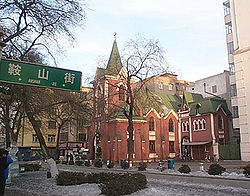 A Protestant church in Harbin, Heilongjiang.
A Protestant church in Harbin, Heilongjiang.
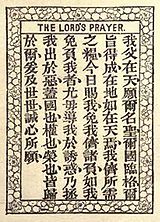 The Lord's Prayer in Classical Chinese, 1889.
The Lord's Prayer in Classical Chinese, 1889.
 St. Mary's Anglican Church, in Hong Kong (Special Administrative Region of China).
St. Mary's Anglican Church, in Hong Kong (Special Administrative Region of China). Main article: Christianity in ChinaSee also: Protestantism in China, Catholicism in China, Chinese house church, Chinese Orthodox Church, and Persecution of Christians in People's Republic of China
Main article: Christianity in ChinaSee also: Protestantism in China, Catholicism in China, Chinese house church, Chinese Orthodox Church, and Persecution of Christians in People's Republic of ChinaChristianity (Chinese: 基督教; pinyin: Jidujiao; literally "Religion of Christ") in China comprises Protestants (Chinese: 新教; pinyin: Xinjiao; literally "New Religion"), Catholics (Chinese: 天主教; pinyin: Tianzhujiao; literally "Religion of the Lord of Heaven"), and a small number of Orthodox Christians. Christianity has been a growing minority religion for over 200 years.[124] Growth has been more significant since the loosening of restrictions on religion after the 1970s within the People's Republic. Religious practices are still often tightly controlled by government authorities. Currently, Chinese over age 18 in the PRC are permitted to be involved with officially sanctioned Christian meetings through the "Three-Self Patriotic Movement" or the "Chinese Catholic Patriotic Association".[125] Many Chinese Christians who want to avoid the state-controlled religious movements meet in unregistered house churches – "risking fines, imprisonment, torture, and even, in some cases, death."[126]
Christianity had existed in China as early as the 7th century AD, having multiple cycles of strong presence for hundreds of years at a time, disappearing for hundreds of years, and then being re-introduced. The arrival of the Persian missionary Alopen in 635, during the early part of the Tang dynasty, is considered by some to be the first entry of the Christian religion into China. What Westerners referred to as Nestorian Christianity flourished for hundreds of years, until Emperor Wuzong of the Tang dynasty adopted anti-religious measures in 845, expelling Buddhism, Christianity, and Zoroastrianism and confiscating their considerable assets. Christianity again came to China in the 13th century during the Mongol-established Yuan dynasty, when the Mongols brought Nestorianism back to the region, and contacts began with the Papacy, such as Franciscan missionaries in 1294. When the native Chinese Ming dynasty overthrew the Yuan dynasty in the 14th century, Christians were again expelled from China.
At the end of the Ming dynasty in the 16th century, Jesuits arrived in Beijing via Guangzhou. The most famous of the Jesuit missionaries was Matteo Ricci, an Italian mathematician who came to China in 1588 and lived in Beijing in 1600. Ricci was welcomed at the imperial court and introduced Western learning into China. The Jesuits followed a policy of accommodation to the traditional Chinese practice of ancestor worship, but this doctrine was eventually condemned by the Pope. Roman Catholic missions struggled in obscurity for decades afterwards.
Christianity began to take root in a significant way in the Chinese Empire during the Qing Dynasty, and although it has remained a minority religion in China, it has had significant recent historical impact. Further waves of missionaries came to China in the Qing Dynasty as a result of contact with foreign powers. Russian Orthodoxy was introduced in 1715 and Protestants began entering China in 1807. The pace of missionary activity increased considerably after the First Opium War in 1842. Christian missionaries and their schools, under the protection of the Western powers, went on to play a major role in the Westernization of China in the 19th and 20th centuries.
The Taiping Rebellion was influenced to some degree by Christian teachings, and the Boxer Rebellion was in part a reaction against Christianity in China. Christians in China established the first modern clinics and hospitals,[127] and provided the first modern training for nurses. Both Roman Catholics and Protestants founded numerous educational institutions in China from the primary to the university level. Some of the most prominent Chinese universities began as religious-founded institutions. Missionaries worked to abolish practices such as foot binding,[128] and the unjust treatment of maidservants, as well as launching charitable work and distributing food to the poor. They also opposed the opium trade[124] and brought treatment to many who were addicted. Some of the early leaders of the Chinese Republic, such as Sun Yat-sen were converts to Christianity and were influenced by its teachings.
The subject of China's Christian population is controversial. The government of the People's Republic of China census enumerated 4 million Roman Catholics and 10 million Protestants.[67][129] However, independent estimates have ranged from 40 million to 54 million Christians in China as the most common and reliable numbers.[23][130][131] Between 1949–2007, indigenous Chinese Christianity has been growing.[132][133] Most of the growth has taken place in the unofficial Chinese house church movement.
Islam
Main articles: Islam in China and History of Islam in China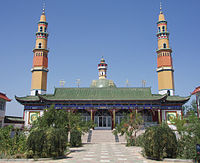 Taizi Mosque in Yinchuan, Ningxia.
Taizi Mosque in Yinchuan, Ningxia.
 The gongbei (shrine) of the Sufi master Yu Baba in Linxia City, Gansu.
The gongbei (shrine) of the Sufi master Yu Baba in Linxia City, Gansu.
Islam in China  HistoryHistory
HistoryHistory
Tang Dynasty • Song Dynasty
Panthay rebellion • 1911-Present
Yuan Dynasty • Ming Dynasty
Qing Dynasty • Dungan revolts (1862-1877, 1895-1896)Major figuresChang Yuchun • Hu Dahai • Mu Ying • Lan Yu • Yeheidie'erding
Hui Liangyu • Ma Bufang
Ma Hualong
Zheng He • Liu Zhi
Haji Noor • Yusuf Ma DexinIslam (called 伊斯兰教, Yisilanjiao or 回教 Huijiao) dates to a mission in 651, only eighteen years after Prophet Muhammad's death, by an envoy led by Sa`d ibn Abi Waqqas, the uncle of Muhammad himself.[134] The Gaozong Emperor showed esteem for Islam and established the Huaisheng Mosque, or Memorial Mosque, in memory of the Prophet.[134] While modern historians say that there is no evidence for Waqqās himself ever coming to China,[135] they do believe that Muslim diplomats and merchants arrived to Tang China within a few decades from the beginning of Muslim Era.[135]
Muslims went to China to trade, virtually dominated the import and export industry by the time of the Song Dynasty, while the office of Director General of Shipping was consistently held by a Muslim.[134][136] Larger immigration began when hundreds of thousands of Muslims were relocated to help to administer China during the Yuan Dynasty.[137] A Muslim, Yeheidie'erding led the construction of the Yuan capital of Khanbaliq, in present-day Beijing.[138] During the Ming Dynasty, Muslims continued their influence on government. Six of the founder of Ming Dynasty, Zhu Yuanzhang's most trusted generals were Muslim, including Lan Yu who led a decisive victory over the Mongols, effectively ending the Mongol dream to re-conquer China. The Yongle Emperor hired Zheng He, China's foremost explorer, to lead seven expeditions to the Indian Ocean. Muslims who were descended from earlier immigration began to assimilate by speaking Chinese dialects and by adopting Chinese names and culture. This era, sometimes considered the Golden Age of Islam in China,[136] also saw Nanjing become an important center of Islamic study.[139]
The rise of the Qing Dynasty (1644–1911) saw numerous rebellions. The Qing rulers belonged to the Manchu, a minority in China. The Muslim revolt in the northwest occurred due to violent and bloody infighting between Muslim sects, the Gedimu, Khafiya, and Jahariyya, while the rebellion in Yunnan occurred because of repression by Qing officials. resulted in five bloody Hui rebellions, most notably the Panthay Rebellion, which occurred in Yunnan province from 1855 to 1873, and the Dungan revolt, which occurred mostly in Xinjiang, Shensi and Gansu, from 1862 to 1877. The Manchu government ordered the execution of all rebels killing a million people in the Panthay rebellion,[138][page needed] several million in the Dungan revolt[138]
However, many Muslims like Ma Zhan'ao, Ma Anliang, Dong Fuxiang, Ma Qianling, and Ma Julung defected to the Qing dynasty side, and helped the Qing general Zuo Zongtang exterminate the Muslim rebels. These Muslim generals belonged to the Khafiya sect, and they helped Qing massacre Jahariyya rebels. General Zuo moved the han around hezhou out of the area and relocated them as a reward for the Muslims there helping Qing kill other Muslim rebels.
In 1895, another Dungan Revolt (1895) broke out, and loyalist Muslims like Dong Fuxiang, Ma Anliang, Ma Guoliang, Ma Fulu, and Ma Fuxiang suppressed and massacred the rebel Muslims led by Ma Dahan, Ma Yonglin, and Ma Wanfu. A Muslim army called the Kansu Braves led by General Dong Fuxiang fought for the Qing dynasty against the foreigners during the Boxer Rebellion. They included well known Generals like Ma Anliang, Ma Fulu, and Ma Fuxiang.
After the fall of the Qing Dynasty, Sun Yat Sen, proclaimed that the country belonged equally to the Han, Manchu, Mongol, Tibetan and Hui people. In the 1920's the provinces of Qinhai, Gansu and Ningxia came under the control of Muslim Governors/Warlords known as the Ma clique. These Muslims served as Military Generals in the National Revolutionary Army and were members of the ruling Kuomintang party of the Republic of China.
During Maoist rule, in the Cultural Revolution, mosques were often defaced, destroyed or closed and copies of the Quran were destroyed along with temples, churches, monasteries, and cemeteries by the Red Guards.[140][141]
Today Islam is experiencing a revival. There is an upsurge in Islamic expression and many nation-wide Islamic associations have organized to co-ordinate inter-ethnic activities among Muslims. Muslims are found in every province in China. Of China's 55 officially recognized minorities, ten groups are predominately Muslim. Statistics are hard to find, and the number of Muslims in China today is somewhere between 20 to 100 million by one source.[134] But most estimates figures that there are 20 to 30 million Muslims (1.5% to 2% of the population).[131][142][143][144][145] while according to government figures, there are 20 million Muslims (1.4%)[134] with 35,000 Islamic places of worship, and more than 45,000 imams. In 2006 a record number of Chinese traveled to Mecca for the hajj, up 40 percent from the previous year.[146]
Judaism
Main article: Judaism in ChinaJudaism (called 犹太教, Youtaijiao in Chinese) was introduced during the Tang Dynasty (between the 7th and the 10th century) or earlier, by small groups of Jews settled in China. The most prominent early community was at Kaifeng, in Henan province (Kaifeng Jews). In the 20th century many Jews arrived in Hong Kong, Shanghai, and Harbin during those cities' periods of economic expansion in the first decades of the century, as well as for the purpose of seeking refuge from anti-Semitic pogroms in Russian Empire (the early 1900s), the communist revolution and civic war in Russia (1917–1918), and anti-Semitic Nazi policy in Central Europe, chiefly in Germany and Austria (1937–1940), and the last wave from Poland and other Eastern European countries (the early 1940s).[147]
Shanghai was particularly notable for its volume of Jewish refugees (Shanghai Ghetto), most of whom left after the war, the rest relocating prior to or immediately after the establishment of the People's Republic. Today, the Kaifeng Jewish community is functionally extinct. Many descendants of the Kaifeng community still live among the Chinese population, mostly unaware of their Jewish ancestry. Meanwhile, remnants of the later arrivals maintain communities in Shanghai and Hong Kong. In recent years a community has also developed in Beijing, especially by Chabad-Lubavitch.
More recently, since the late 20th century, along with the study of religion in general, the study of Judaism and Jews in China as an academic subject has begun to blossom (i.e. Institute of Jewish Studies (Nanjing), China Judaic Studies Association).[148]
Non-Han indigenous religions
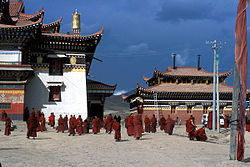 The Narshi Gompa, a Bönpo monastery in Aba, Sichuan.
The Narshi Gompa, a Bönpo monastery in Aba, Sichuan. Main articles: Moz (religion), Bön, White Stone Religion, and Dongbaism
Main articles: Moz (religion), Bön, White Stone Religion, and DongbaismBesides Han Chinese practicing their ethnic Shenism, various Chinese non-Han minority ethnicities have retained their own ethnic religions. An estimate puts the number of followers of these tribal religions at roughly 60 million, or 4% of the whole Mainland Chinese population (it's not clear whether the figure includes Tibetan and Theravada Buddhists).[21] The Government of the People's Republic of China promotes and protects the tribal religions of minority nations as pivotal expression of their cultural identity.
Numerically, the most significant tribal religion is that of the Zhuang, a people inhabiting the Zhuang Autonomous Region of Guangxi. About 80–90% out of 18 million of the Zhuang follow their ethnic faith, Moz (Chinese: 摩教, Mojiao).[149] It is a polytheistic, animistic and shamanic system codified into a mythology and a sacred scripture, the Buluotuo Epic. A very similar religion of the same name is adhered to by the Zhuang-related Buyei people.
Bön (Tibetan: བོན་; called 苯教, Benjiao by the Chinese) is the oldest spiritual tradition of Tibet, dominant before the introduction of Buddhism. The Bönpo religion is traditionally considered founded by the mythical figure of Tonpa Shenrab Miwoche. With the spread of Buddhism, Bön incorporated styles, iconography and clergy system of the new religion, whereas remaining a distinguished tradition. Simultaneously, Bönpo elements combined with original Buddhism gave origin to Tibetan Buddhism. An estimated 10% of Tibetans follow Bön.
The traditional religion of the Qiang people (200.000, most residing in north-western Sichuan) has been recently systematised into the so-called White Stone Religion following competition by institutional Taoism and Buddhism. Nowadays most of the Qiang follow it, a system which is mainly animistic and pantheistic, focusing on the worship of nature.[150] In the White Stone Religion white stones are symbols of the Qiang gods, particularly the God of Heaven, the God of Earth, the God of the Mountains, the God of the Trees and the Goddess of the Mountains.[151]
Dongbaism (東巴教, Dongbajiao in Chinese) is the primary religion of the Nakhi people. About two-thirds of today Nakhis (200.000 on 300.000) are Dongbaists. Although it has remained exclusive to the Nakhis, the Dongbaist religion is not considered native by scholars. Deep similarities between Dongbaist practices and the Bönpo ones seem to proof that Dongbaism arose roughly during the 11th or 12th century. Bönpos are considered to have settled among the Nakhis spreading their religion; Dongbaism eventually originated by the combination of Bön with Nakhi native beliefs. Dongbaists worship nature, personified by human-snake-chimera creatures called Shv or Shu.
In the Moz, Qiang and Dongbaist religions, as well as in the tribal religions of other minorities, structures similar to those of Taoism are identifiable, particularly in the clergy system. Ritual specialists of these religions are very similar in social function to Taoist masters. This is because in imperial times, the Chinese central governments sent Taoist missionaries to national minorities in Southern China in order to incorporate their religions into official institutional Taoism, expanding and establishing governmental power.
New religious movements
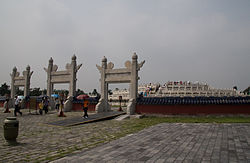 The Round Mound Altar, the altar proper at the Temple of Heaven in Beijing, where the Emperor communed with Heaven.
The Round Mound Altar, the altar proper at the Temple of Heaven in Beijing, where the Emperor communed with Heaven.
A great diversity of new religious movements are thriving across China.[58] The majority are indigenous, and into this group some are totally new whilst others were already active before the communist revolution in 1949, and are being re-introduced from Taiwan. The most relevant among these last are Yiguandao (and other sects within the Xiantianism category),[59] Tiendery-Tientism,[60] Yaochidao and Zailiism.[30]
Among the very new ones the most notable are the various Qigong-inspired groups, such as Falun Gong, Zhong Gong, Yuanji Gong and Wang Gong, and Christian-inspired Taiping-style sects such as Zhushenism, Linglingism, Fuhuodao, Mentuhui and Lightning from the East.[61][62] Other movements are allogenous in origin, for example the Bahá'í Faith.[63]
Other religions
Heaven worship
Main article: Heaven worshipThe Heaven worship was the bureaucratic belief system subscribed to by most dynasties of China until the overthrow of the Qing Dynasty. It was a panentheistic system, centering on the worship of Tian (the "Heaven") as an omnipotent force. This religious system predated Taoism, Confucian thought and the introduction of Buddhism and Christianity; its dogmas supported the basements of the imperial hierarchy.
It had monotheistic features in that Heaven was seen as an omniscient entity, endowed with personality but no corporeal form. Heaven as a monotheistic god was variously referred to as Shangdi (literally "Lord Above"). Worship of Heaven included the erection of temples, the last and greatest being the Temple of Heaven in Beijing, and the offering of prayers. Heaven was believed to manifest itself through the powers of the weather and natural disasters. No iconographies were permitted in Heaven worship. Heaven was seen as a judge of humans. Especially evil people were believed to be killed by Heaven through lightning, with their crimes inscribed on their (burnt) spines.
From the writings of Confucius, we find that Confucius himself believed that Heaven cannot be deceived, Heaven guides people's lives and maintains a personal relationship with them, and that Heaven gives tasks for people to fulfill to teach them righteousness (yi, 義).[21] However, this faith system was not truly monotheistic since other lesser gods and spirits, which varied with locality, were also worshiped along with Shangdi. Still, variants such as Mohism approached high monotheism, teaching that the function of lesser gods and ancestral spirits is merely to carry out the will of Shangdi, which included observing "universal love" (jian'ai, 兼爱) and shunning fatalism.
After the advent of Taoism and Buddhism, Heaven monotheism faded in popular belief. However, some of its concepts remained in use throughout the premodern period. These concepts, often influenced heavily by Confucian theory, include the Mandate of Heaven, the Emperor's role as Son of Heaven, and the legitimate overthrow of a dynasty when its "mandate" ended. These structures actually consolidated the authority of the Emperor.
Emperors who favoured Taoism and Buddhism neglecting the worship of Heaven were often seen as anomalous. Elements were also incorporated in Chinese folk religion. Execution by lightning, for example, became one of the roles of the thunder gods. The concept of the almighty Heaven remained in popular expressions. Where an Anglophone would say "Oh my God" or "Thank God", a Chinese person might say "Oh Heaven" ("老天!" or "天哪!") or "Thank the heavens and the earth" ("謝天謝地").
Manichaeism
Manichaeism (called 摩尼教, Monijiao), an Iranic religion, entered China between the 6th century and the 8th century due to contacts between the Tang Dynasty and states of Central Asia, particularly Tokharistan.[152] In 731, a Manichaean priest was asked by the Chinese Emperor to realize a summary of the religion's teachings. He wrote the Compendium of the Teachings of Mani the Buddha of Light. The Tang government approved Manichaeism to be practiced by foreigners but prohibited preaching among Chinese people.[152]
A turning point occurred in 762 with the conversion of Bogu Khan of the Uyghurs.[152] Since 755, the Chinese Empire had been weakened by the An Shi Rebellion, and the Uyghurs had become the only fighting force serving the Tang Dynasty. Bogu Khan encouraged Manichaeism to spread in China. Manichaean temples were established in the two capitals, Chang'an and Luoyang, as well as in several other cities in the Northern and Central China.[152]
The decay of Uyghur power in 840 brought the closure of many Manichaean institutions.[152] Emperor Wuzong of Tang started the Great Anti-Buddhist Persecution, which was not exclusively against Buddhism but extended to all foreign religions. The religion was severely suppressed, but didn't die out. During the period of the Five Dynasties, it re-emerged as a popular underground phenomenon, particularly in Southern China.[152]
In 1120, a rebellion led by Fang Xi was believed to be caused by adherents of underground religious communities, whose meeting places were said to host political protests. This event brought crackdowns of unauthorized religious congregations and destruction of scriptures. In 1280, the Mongol rule gave a century of freedom to Manichaeism,[152] but, in 1368, the Ming Dynasty started new persecutions.[152] The religion gradually collapsed, eventually dying out during the following centuries.
Hinduism
Main article: Hinduism in China An apsara from the Longmen Grottoes in Luoyang, China.
An apsara from the Longmen Grottoes in Luoyang, China.
Hinduism is a minor religion in The People's Republic of China, with roughly about 130,000 followers and composing only of 0.01% of China's total population.
Some examples of influence by Hinduism on ancient Chinese religion included the belief of "Six Schools" or "Six Doctrines" as well as use of Yoga, stupas (later became pagoda in East Asia). However, in China, Hinduism has never gained much popularity, unlike the beliefs of Buddhism.
There was a small Hindu community in China, mostly situated in southeastern China. A late 13th-century bilingual Tamil and Chinese-language inscription has been found associated with the remains of a Shiva temple in Quanzhou. This was one of possibly two south Indian-style Hindu temples that were built in the southeastern sector of the old port, where the foreign traders' enclave was formerly located.
Zoroastrianism
Zoroastrianism (called 琐罗亚斯德教, Suoluoyasidejiao, or 祆教, Xianjiao) expanded in Northern China during the 6th century via the Silk Road. It gained the status of an official religion in some Chinese regions. Zoroastrian fire temples have been found in Kaifeng and Zhenjiang. According to some scholars, they remained active until the 12th century, when the religion started to fade from the Chinese landscape.
See also
- Main religions
- Pre-modern religions
- Heaven worship
- Wonderism
- Other religions
- Bön
- Dongbaism
- Xiantianism
- Falun Gong
- Hinduism in China
- Judaism in China
- Concepts
- Hun and po
- Opium of the people
- Other areas
References
- ^ Taylor, Rodney L. "Proposition and Praxis: The Dilemma of Neo-Confucian Syncretism". Philosophy of East and West, Vol. 32, No. 2 (Apr., 1982). pg. 187
- ^ Gunn, Torri (2011). Defining Religion with Chinese Characters: Interrogating the Criticism of the Freedom of Religion in China.. Ottawa, Ontario: University of Ottawa. pp. 17–50. http://www.ruor.uottawa.ca/en/bitstream/handle/10393/19878/Gunn_Torri_Kenneth_2011_thesis.pdf?sequence=3.
- ^ "State, Society And Religious Engineering: Towards A Reformist Buddhism In Singapore – Research and Read Books, Journals, Articles at Questia Online Library". Questia.com. http://www.questia.com/googleScholar.qst?docId=5008625740. Retrieved 2011年10月17日.
- ^ a b "Over 10,000 Chinese Worship Huangdi in Henan". China.org.cn. 2006年04月01日. http://www.china.org.cn/english/2006/Apr/164216.htm. Retrieved 2011年10月17日.
- ^ a b "Compatriots across the strait honor their ancestry". English.hebei.gov.cn. 2010年08月18日. http://english.hebei.gov.cn/2010-08/18/content_11169296.htm. Retrieved 2011年10月17日.
- ^ a b The Yan-huang Culture Festival and Worshiping Ceremony
- ^ a b "Return to folk religions brings about renewal in rural China. By Edward A. Gargan ("Philadelphia Inquirer," September 14, 2001)". Wwrn.org. 2001年09月14日. http://wwrn.org/articles/13093/?&place=china/taiwan§ion=native-religions. Retrieved 2011年10月17日.
- ^ a b The Politics of Legitimation and the Revival of Popular Religion in Shaanbei, North-Central China
- ^ a b "Miraculous response: doing popular religion in contemporary China". Books.google.it. http://books.google.it/books?id=KSpDTsSkuVoC&pg=PA77&lpg=PA77&dq=%22black+dragon%22+temple+shaanxi&source=bl&ots=uPhxPBoNvN&sig=dlv_oYpHi2YiNH18DgDzLyX--iQ&hl=it&ei=3Dl6TJ2hCo6ROMGY8eQG&sa=X&oi=book_result&ct=result&resnum=9&ved=0CD0Q6AEwCDgU#v=onepage&q=%22black%20dragon%22%20temple%20shaanxi&f=false. Retrieved 2011年10月17日.
- ^ a b "苍南金乡玄坛庙成华夏第八财神庙". Blog.voc.com.cn. http://blog.voc.com.cn/blog.php?do=showone&type=blog&cid=104&itemid=624736. Retrieved 2011年10月17日.
- ^ Name (required) (2011年01月08日). "Separation of Church and State – Part 3/3". Ilookchina.net. http://ilookchina.net/2011/01/08/separation-of-church-and-state-%E2%80%93-part-33/. Retrieved 2011年10月17日.
- ^ a b c "Adherents.com". Adherents.com. http://www.adherents.com/Religions_By_Adherents.html#Chinese. Retrieved 2011年10月17日.
- ^ a b c ChartsBin (2009年09月16日). "Chinese Folk Religion Adherents by Country". Chartsbin.com. http://chartsbin.com/view/sgx. Retrieved 2011年10月17日.
- ^ a b c "How Now Tao?". Asia Sentinel. http://asiasentinel.com/index.php?option=com_content&task=view&id=468&Itemid=34. Retrieved 2011年10月17日.
- ^ a b "China's Leaders Harness Folk Religion For Their Aims". Npr.org. 2010年07月23日. http://www.npr.org/templates/story/story.php?storyId=128672542&sc=tw. Retrieved 2011年10月17日.
- ^ a b c "Buddhism in China. By staff reporter ZHANG XUEYING". Chinatoday.com.cn. http://www.chinatoday.com.cn/ctenglish/se/txt/2009-06/19/content_203310.htm. Retrieved 2011年10月17日.
- ^ a b c ANALYSIS May 1, 2008 (2008年05月01日). "Religion in China on the Eve of the 2008 Beijing Olympics". Pew Forum. http://pewforum.org/Importance-of-Religion/Religion-in-China-on-the-Eve-of-the-2008-Beijing-Olympics.aspx. Retrieved 2011年10月17日.
- ^ a b c "Prof: Christians remain a small minority in China today". Purdue.edu. 2010年07月26日. http://www.purdue.edu/newsroom/research/2010/100726T-YangChina.html. Retrieved 2011年10月17日.
- ^ Buddhism Thrives as China Relaxes Religious Policy. My Sinchew 2009.07.07.
- ^ 少数民族. "少数民族_互动百科". Hudong.com. http://www.hudong.com/wiki/%E5%B0%91%E6%95%B0%E6%B0%91%E6%97%8F. Retrieved 2011年10月17日.
- ^ a b c d ChartsBin (2009年09月16日). "Tribal Religion Adherents by Country". Chartsbin.com. http://chartsbin.com/view/30s. Retrieved 2011年10月17日.
- ^ a b "Survey finds 300m China believers". BBC News. 2007年02月07日. http://news.bbc.co.uk/2/hi/asia-pacific/6337627.stm. Retrieved 2010年05月22日.
- ^ a b c "China Survey Reveals Fewer Christians than Some Evangelicals Want to Believe". Assistnews.net. 2007年10月01日. http://www.assistnews.net/STORIES/2007/s07100011.htm. Retrieved 2011年10月17日.
- ^ a b c "Purdue Newsroom – Prof: Christians remain a small minority in China today". Purdue.edu. 2010年07月26日. http://www.purdue.edu/newsroom/research/2010/100726T-YangChina.html. Retrieved 2011年10月17日.
- ^ a b ANALYSIS May 1, 2008 (2008年05月01日). "2008 Pew Forum survey". Pewforum.org. http://pewforum.org/Importance-of-Religion/Religion-in-China-on-the-Eve-of-the-2008-Beijing-Olympics.aspx. Retrieved 2011年10月17日.
- ^ "Christianity Gaining Popularity in China". Fox News. 2008年08月08日. http://www.foxnews.com/story/0,2933,400141,00.html. Retrieved 2011年10月17日.
- ^ "CIA – The World Factbook – China". Cia.gov. https://www.cia.gov/library/publications/the-world-factbook/geos/ch.html#People. Retrieved 2011年10月17日.
- ^ a b "Adherents.com". Adherents.com. http://www.adherents.com/Na/Na_473.html. Retrieved 2011年10月17日.
- ^ a b c Top 50 Countries With Highest Proportion of Atheists / Agnostics (Zuckerman, 2005)Source: Zuckerman, Phil. "Atheism: Contemporary Rates and Patterns", chapter in The Cambridge Companion to Atheism, ed. by Michael Martin, Cambridge University Press: Cambridge, UK (2005).
- ^ a b c David Ownby. Falun Gong and the Future of China. Oxford University Press, 2008.
- ^ a b c Kim Hwan-young. Revival of Confucianism could unify Asia Korea JoongAng Daily.
- ^ "Photo in the News: Tallest Pagoda Opens in China – National Geographic". News.nationalgeographic.com. 2010年10月28日. http://news.nationalgeographic.com/news/2007/05/070501-tallest-pagoda.html. Retrieved 2011年10月17日.
- ^ a b "Buddha Relics Enshrined in World's Highest Pagoda". En.chinagate.cn. http://en.chinagate.cn/photos/2009-05/10/content_17751739.htm. Retrieved 2011年10月17日.
- ^ "Animism". OMF. http://www.omf.org/omf/uk/asia/religions/animism. Retrieved 2011年10月17日.
- ^ "Folk Religion, Shamanism And Ancestor Worship In China – China". Facts and Details. http://factsanddetails.com/china.php?itemid=85&catid=3&subcatid=8. Retrieved 2011年10月17日.
- ^ "Shamanism in Encyclopedia". Tutorgig.com. http://www.tutorgig.com/ed/Shamanism. Retrieved 2011年10月17日.
- ^ Barend ter Haar. "Shamanism in China: bibliography by Barend ter Haar". Website.leidenuniv.nl. http://website.leidenuniv.nl/~haarbjter/shamanism.htm. Retrieved 2011年10月17日.
- ^ "local beliefs". People.cohums.ohio-state.edu. http://people.cohums.ohio-state.edu/bender4/eall131/EAHReadings/module03/local_beliefs.html. Retrieved 2011年10月17日.
- ^ "Aurélie Névot, Comme le sel, je suis le cours de l'eau: le chamanisme à écriture des Yi du Yunnan (Chine) (Like salt, I follow the current: The literate Shamanism of the Yi of Yunnan)". Chinaperspectives.revues.org. 2010年06月01日. http://chinaperspectives.revues.org/5288. Retrieved 2011年10月17日.
- ^ "ACLS: Collaborative Research Network". Yale.edu. http://www.yale.edu/seacrn/asia_members.htm. Retrieved 2011年10月17日.
- ^ "The Manchu Ethnic Group". China.org.cn. http://www.china.org.cn/english/features/EthnicGroups/136932.htm. Retrieved 2011年10月17日.
- ^ english@peopledaily.com.cn. "People's Daily Online The Xibe ethnic minority". English.peopledaily.com.cn. http://english.peopledaily.com.cn/data/minorities/Xibe.html. Retrieved 2011年10月17日.
- ^ "About.com: Agnosticism / Atheism – Religion in China: General Information". Atheism.about.com. 2009年12月16日. http://atheism.about.com/library/world/AJ/bl_ChinaIndex.htm. Retrieved 2011年10月17日.
- ^ "China's Policy on Religion". English.people.com.cn. http://english.people.com.cn/92824/92845/92875/6442436.html. Retrieved 2011年10月17日.
- ^ Harvard – Tacit Knowledge in Taoism and Its Influence on Chinese Culture
- ^ "White Paper-Freedom of Religious Belief in China". China-embassy.org. 2003年10月23日. http://www.china-embassy.org/eng/zt/zjxy/t36492.htm. Retrieved 2011年10月17日.
- ^ "New Believers: A Religious Revolution In China". NPR. http://www.npr.org/templates/story/story.php?storyId=128644059. Retrieved 2011年10月17日.
- ^ WorldWide Religious News-China statute uses 'religion' for first time
- ^ a b Council of Foreign Relations. Symposium on Religion and the Future of China: Religion, Civil Society, and Economic Life. June 11, 2008.
- ^ a b Hill Gates – Robert P. Weller. Hegemony of Chinese Folk Ideologies. Sage Publications, 1987.
- ^ a b Gordon Redding. The Spirit of Chinese Capitalism. Walter de Grutyer, 1990.
- ^ a b Hill Gates. China's motor: one thousand years of petty-capitalism. Cornell University, 1996.
- ^ Graeme Lang, Lars Ragvald. Grasping the Revolution: Fieldwork on Religion in China. Department of Asian and International Studies, City University of Hong Kong. Retrieved 31st July 2011.
- ^ a b Mayfair Mei-hui Yang (Director of Asian Studies, University of Sydney, Australia). Ritual Economy and Rural Capitalism with Chinese Characteristics. University of California Press. Retrieved 31st July 2011.
- ^ a b Pui-lam Law. The Revival of Folk Religion and Gender Relationships in Rural China. Hong Kong Polytechnic University Press. Retrieved 31st July 2011.
- ^ "In China, A Different Brand of Buddhism – Ethnic Han Turning To Tibetan Doctrine For Guidance". The Washington Post. http://www.washingtonpost.com/wp-dyn/content/article/2009/02/18/AR2009021803201.html. Retrieved 2011年10月17日.
- ^ http://www.unhcr.org/refworld/pdfid/4b6fe1b70.pdf
- ^ a b Robin Munro. Detained in China and Tibet: a directory of political and religious prisoners. p. 269: list of proscribed Buddhist and Taoist-inspired sects.
- ^ a b "Yiguandao in China" (PDF). http://www.unhcr.org/refworld/pdfid/4b6fe1950.pdf. Retrieved 2011年10月17日.
- ^ a b "Religions in Taiwan: Between Mercantilism and Millenarianism" (PDF). http://nirc.nanzan-u.ac.jp/publications/miscPublications/I-R/pdf/32-Vermander.pdf. Retrieved 2011年10月17日.
- ^ a b Kristin Kupfer. Geheimgesellschaften in der VR China.
- ^ a b Tony Lambert. Chinese cults target youth.
- ^ a b "Video: Chinese Baha'is in 1985". Google. http://video.google.com/videoplay?docid=6820999916625688070#. Retrieved 2011年10月17日.
- ^ Robin Munro. Detained in China and Tibet: a directory of political and religious prisoners.
- ^ "U.S. Department of States: International Religious Freedom Report 2007 – China (includes Tibet, Hong Kong, and Macau)". State.gov. http://www.state.gov/g/drl/rls/irf/2007/90133.htm. Retrieved 2011年10月17日.
- ^ Religious beliefs[dead link]
- ^ a b "China in Brief –". China.org.cn. 2000年07月13日. http://www.china.org.cn/e-china/religions/belief.htm. Retrieved 2011年10月17日.
- ^ O'Brien, Joanne, and Palmer, Martin. "The Atlas of Religion". University of California Press (Berkely, 1993) in Zuckerman, pg. 53
- ^ "Survey finds 300 million China believers". BBC News. 2007年02月07日. http://news.bbc.co.uk/2/hi/asia-pacific/6337627.stm. Retrieved 2011年10月17日.
- ^ "Religious Believers thrice the estimate". China Daily. http://www.chinadaily.com.cn/china/2007-02/07/content_802994.htm. Retrieved 2011年10月17日.
- ^ "Religious Believers Thrice The Official Estimate Poll". China Daily, February 7, 2007. Chinadaily.com.cn
- ^ a b c "Buddhists in the world". Thedhamma.com. 2009年07月07日. http://thedhamma.com/buddhists_in_the_world.htm. Retrieved 2011年10月17日.
- ^ a b SEANET Work – "Counting the Buddhist World Fairly," by Dr. Alex Smith (archived from the original on 2005-02-05).
- ^ "Major Religions Ranked by Size". Adherents.com. http://adherents.com/Religions_By_Adherents.html#Chinese. Retrieved 2011年10月17日.
- ^ "Religions and Beliefs in China". Travelchinaguide.com. http://www.travelchinaguide.com/intro/religion. Retrieved 2011年10月17日.
- ^ "SACU Religion in China". Sacu.org. http://www.sacu.org/religion.html. Retrieved 2011年10月17日.
- ^ "Index-China Chinese Philosophies and religions". Index-china.com. http://www.index-china.com/index-english/people-religions-s.html. Retrieved 2011年10月17日.
- ^ "The Diaspora Han Chinese". Kcm.co.kr. http://kcm.co.kr/bethany_eng/clusters/8072.html. Retrieved 2011年10月17日.
- ^ "U.S. Department of States – International Religious Freedom Report 2006: China (includes Tibet, Hong Kong, and Macau)". State.gov. http://www.state.gov/g/drl/rls/irf/2006/71338.htm. Retrieved 2011年10月17日.
- ^ Zuckerman, Phil. "Atheism: Contemporary Numbers and Patterns". In Martin, Michael "The Cambridge Companion to Atheism". (New York: Cambridge University Press) 2006. pg. 47
- ^ Overmeyer, Daniel L. et al. "Introduction". The Journal of Asian Studies, Vol. 54, No. 2 (May, 1995). pp. 314–321
- ^ Ethel R. Nelson, Richard E. Broadberry, and Ginger Tong Chock. God's Promise to the Chinese. p 8. ISBN 0-937869-01-5.
- ^ "Faiths in turmoil in China, says report". Cathnews India. http://www.cathnewsindia.com/2010/08/13/faiths-in-turmoil-in-china-says-report/. Retrieved 2011年10月17日.
- ^ "Over 23 million Christians in country". China Daily. 2010年08月12日. http://www.chinadaily.com.cn/usa/2010-08/12/content_11144948.htm. Retrieved 2011年10月17日.
- ^ "Living in China: Over 23 million Christians « { design@tive } information design". Designative.info. 2010年08月19日. http://designative.info/2010/08/19/living-in-china-over-23-million-christians/. Retrieved 2011年10月17日.
- ^ a b http://www.chinanews.cn/culture_education/2007-12-12/41982.html[dead link]
- ^ "Confucius Institute Headquarters Founded in Beijing –". China.org.cn. 2007年04月10日. http://china.org.cn/english/photo/206586.htm. Retrieved 2011年10月17日.
- ^ Daily Estimate. China: Confucius back in Beijing with a statue in Tiananmen Square.
- ^ a b c d e f g h i Fenggang Yang. Cultural Dynamics in China: Today and in 2020. Asia Policy, Number 4. July 2007. p. 48: Confucian Fundamentalism.
- ^ "Reinventing Chinese Syncretic Religion: Shenism". Books.google.it. http://books.google.it/books?id=GBdX2ELnkXQC&pg=PA21&lpg=PA21&dq=shenism&source=bl&ots=qka8h6eumX&sig=yDpuMWDV4RZsuUlMRGR3NIfPQ2s&hl=it&ei=R0YATO3eDYmqnAOW3IyUAQ&sa=X&oi=book_result&ct=result&resnum=4&ved=0CCgQ6AEwAw#v=onepage&q=shenism&f=false. Retrieved 2011年10月17日.
- ^ "How we came to ‘pai shen’". Blogs.straitstimes.com. 2009年09月07日. http://blogs.straitstimes.com/2009/9/7/how-we-came-to-pai-shen. Retrieved 2011年10月17日.
- ^ "Religious diversity in Singapore". Books.google.it. 2001年09月11日. http://books.google.it/books?id=9MmNaNebFD8C&pg=PA198&lpg=PA198&dq=shenism&source=bl&ots=RLmEXv8QPy&sig=V1HzACgtvIHMI3nOENP2Oy5DiAM&hl=it&ei=2EYATPOJDYn-mQP97-2vDA&sa=X&oi=book_result&ct=result&resnum=8&ved=0CDUQ6AEwBzgK#v=onepage&q=shenism&f=false. Retrieved 2011年10月17日.
- ^ Unofficial Religion in China: Beyond the Party's Rules. Roundtable before the Congressional-Executive Commission on China. May 2005. p.36: revival of Chinese Ethnic Religion in Mainland China.
- ^ Richard Madsen. The Upsurge of Religion in China. Journal of Democracy, Volume 21, Number 4. October 2010.
- ^ WantChinaTimes. Confucius Returns To China.
- ^ Shanghaiist. Confucius statue unveiled near Tiananmen Square.
- ^ Miller (2003), p. ix.
- ^ a b "Taoism History". Travel China Guide. http://www.travelchinaguide.com/intro/religion/taoism/history.htm. Retrieved 2011年10月17日.
- ^ Judith A. Berling, "Taoism, or the Way," at: [1]
- ^ a b "Rebirth of Taoism fills spiritual void in rush to consumerism" (PDF). http://www.arcworld.org/downloads/SCMP%20Daoism%2030%20April%202007.pdf. Retrieved 2011年10月17日.
- ^ "The history of two Taoist temples: the Baiyunguan in Shanghai, China, and the Bok Kai in Marysville, California. | Goliath Business News". Goliath.ecnext.com. 2007年01月01日. http://goliath.ecnext.com/coms2/gi_0199-6375255/The-history-of-two-Taoist.html. Retrieved 2011年10月17日.
- ^ "The Way of Harmony: International Forum on the Daodejing – News". China.org.cn. http://www.china.org.cn/english/daodeforum/207879.htm. Retrieved 2011年10月17日.
- ^ Keen Zhang. Academics to promote oriental wisdom of Daoism. China.org.cn, November 11, 2009.
- ^ Maspero, Henri. Translated by Frank A. Kierman, Jr. Taoism and Chinese Religion. pg 46. University of Massachusetts, 1981.
- ^ a b Prebish, Charles. Buddhism: A Modern Perspective. Pg 192. Penn State Press, 1975. ISBN 0271011955.
- ^ Dumoulin, Heinrich, Heisig, James W. & Knitter, Paul. Zen Buddhism: A History (India and China). Pp 68, 70–73, 167–168. World Wisdom, Inc, 2005. ISBN 0941532895.
- ^ Dumoulin, Heinrich, Heisig, James W. & Knitter, Paul. Zen Buddhism: A History (India and China). Pp 166–167, 169–172. World Wisdom, Inc, 2005. ISBN 0941532895.
- ^ Dumoulin, Heinrich, Heisig, James W. & Knitter, Paul. Zen Buddhism: A History (India and China). Pp 189–190, 268–269. World Wisdom, Inc, 2005. ISBN 0941532895.
- ^ Moore, Charles Alexander. The Chinese Mind: Essentials of Chinese Philosophy and Culture. Pp 133, 147. University of Hawaii Press. 1967. ISBN 0824800753.
- ^ "Buddhists praised for contributions". China Daily. 2006年12月22日. http://www.chinadaily.com.cn/china/2006-12/22/content_765071.htm. Retrieved 2011年10月17日.
- ^ ""Counting the Buddhist World Fairly," by Dr. Alex Smith". Seanetwork.org. http://www.seanetwork.org/article.php?story=20041020143036414. Retrieved 2011年10月17日.
- ^ Roberts, Dexter (2008年01月10日). "China's Spiritual Awakening". Bloomberg BusinessWeek. http://www.businessweek.com/magazine/content/08_03/b4067050290718.htm. Retrieved 2011年10月17日.
- ^ "Giant Buddhist Statue Enshrined in Hainan". China Daily. http://www.chinadaily.com.cn/english/doc/2005-04/16/content_434745.htm. Retrieved 2011年10月17日.
- ^ "Holy statue of Guanyin Buddha unveiled". English.sina.com. 2005年04月24日. http://english.sina.com/china/1/2005/0424/28898.html. Retrieved 2011年10月17日.
- ^ "China bans mining on sacred Buddhist mountains". Reuters. 2007年08月23日. http://www.reuters.com/article/topNews/idUSPEK25205720070823.
- ^ "China temple opens tallest pagoda". BBC News. 2007年05月01日. http://news.bbc.co.uk/2/hi/asia-pacific/6610999.stm. Retrieved 2010年05月22日.
- ^ "Photo in the News: Tallest Pagoda Opens in China". News.nationalgeographic.com. 2010年10月28日. http://news.nationalgeographic.com/news/2007/05/070501-tallest-pagoda.html. Retrieved 2011年10月17日.
- ^ "China inaugurates 'world's tallest pagoda' – INQUIRER.net, Philippine News for Filipinos". http://newsinfo.inquirer.net/breakingnews/world/view_article.php?article_id=63479. Retrieved 2011年10月17日.
- ^ Tzu Chi Foundation Approved To Open Branch In Mainland China – ChinaCSR.com – Corporate Social Responsibility (CSR) News and Information for China[dead link]
- ^ ""Buddha remains" unveiled in east China temple – Xinhua". News.xinhuanet.com. 2010年06月12日. http://news.xinhuanet.com/english2010/china/2010-06/12/c_13346882.htm. Retrieved 2011年10月17日.
- ^ "'Buddha remains' unveiled in East China temple". China Daily. 2010年06月12日. http://www.chinadaily.com.cn/china/2010-06/12/content_9971941.htm. Retrieved 2011年10月17日.
- ^ "World-famed tower to enshrine Buddha remains". China.org.cn. 2010年08月13日. http://www.china.org.cn/china/2010-08/13/content_20705413.htm. Retrieved 2011年10月17日.
- ^ MacArtney, Jane (2007年08月04日). "China tells living Buddhas to obtain permission before they reincarnate". The Times (London). http://www.timesonline.co.uk/tol/news/world/article2194682.ece. Retrieved 2010年05月22日.
- ^ a b Austin, (2007)
- ^ Johnstone, Patrick (2001). Operation World. London: Paternoster. p.165
- ^ McGeown, Kate (November 9, 2004). . "China's Christians suffer for their faith". BBC News. http://news.bbc.co.uk/2/hi/asia-pacific/3993857.stm .. Retrieved 2008年05月06日.
- ^ Gulick, (1975) pp. 561–562
- ^ Burgess, (1957) pp. 47
- ^ "How To Count The Number Of Christians In China". Amitynewsservice.org. 2011年04月19日. http://www.amitynewsservice.org/page.php?page=1151. Retrieved 2011年10月17日.
- ^ "Asia-Pacific | Survey finds 300m China believers". BBC News. 2007年02月07日. http://news.bbc.co.uk/2/hi/asia-pacific/6337627.stm. Retrieved 2011年10月17日.
- ^ a b "CIA – The World Factbook – China". Cia.gov. https://www.cia.gov/library/publications/the-world-factbook/geos/ch.html#People. Retrieved 2011年10月17日.
- ^ Johnstone, Patrick (2001). Operation World. London: Paternoster. p.164
- ^ "Counting Christians in China: a cautionary report. Industry & Business Article – Research, News, Information, Contacts, Divisions, Subsidiaries, Business Associations". Goliath.ecnext.com. 2003年01月01日. http://goliath.ecnext.com/coms2/gi_0199-977347/Counting-Christians-in-China-a.html. Retrieved 2011年10月17日.
- ^ a b c d e "BBC Islam in China (650–present)". BBC. 2002年10月02日. http://www.bbc.co.uk/religion/religions/islam/history/china_1.shtml. Retrieved 2011年10月17日.
- ^ a b Lipman, Jonathan Newman. "Familiar Strangers, a history of Muslims in Northwest China". page 25. University of Washington Press, 1997. ISBN 0-295-97644-6.
- ^ a b "Islamic culture in China". Religion-online.org. http://www.religion-online.org/showchapter.asp?title=1656&C=1645. Retrieved 2011年10月17日.
- ^ Islamic Education in China[dead link]
- ^ a b c Gernet, Jacques. A History of Chinese Civilization. 2. New York: Cambridge University Press, 1996.ISBN 0-521-49712-4
- ^ Looking East: The challenges and opportunities of Chinese Islam[dead link]
- ^ Goldman,Merle (1986). Religion in Post-Mao China, The Annals of the American Academy of Political and Social Science. 483.1:145-56
- ^ "Muslims in China". Saudiaramcoworld.com. http://www.saudiaramcoworld.com/issue/198504/muslims.in.china-an.introduction.htm. Retrieved 2011年10月17日.
- ^ "China (includes Hong Kong, Macau, and Tibet)". State.gov. http://www.state.gov/g/drl/rls/irf/2006/71338.htm. Retrieved 2011年10月17日.
- ^ "China Muslim Silaturrahim". Chinamuslim.net. http://www.chinamuslim.net/origin/origin.htm. Retrieved 2011年10月17日.
- ^ "NW China region eyes global Muslim market". China Daily. 2008年07月09日. http://www.chinadaily.com.cn/bizchina/2008-07/09/content_6831389.htm. Retrieved 2011年10月17日.
- ^ "Muslim Media Network". Muslim Media Network. 2008年03月24日. http://muslimmedianetwork.com/mmn/?p=1922. Retrieved 2011年10月17日.
- ^ "4 Chinese Muslims die during Haj". China Daily. http://www.chinadaily.com.cn/china/2006-12/28/content_769373.htm. Retrieved 2011年10月17日.
- ^ "Encyclopedia of Diasporas. Immigrant and Refugee Cultures Around the World. Vol. I, Jewish Diaspora in China by Xu Xin, pp.152–163, Ember, Melvin; Ember, Carol R.; Skoggard, Ian (Eds.), Springer 2004, ISBN 0306483211". Books.google.pl. http://books.google.pl/books?id=7QEjPVyd9YMC&printsec=frontcover&source=gbs_summary_r&cad=0#PPA156,M1. Retrieved 2011年10月17日.
- ^ "China Judaic Studies Association". Oakton.edu. http://www.oakton.edu/user/~friend/chinajews.html. Retrieved 2011年10月17日.
- ^ http://www.chinatravel.com/facts/chinese-ethnic-groups/zhuang-ethnic-minority-.htm Zhuang Ethnic Minority
- ^ "Qiang Ethnic Group". Factsanddetails.com. http://factsanddetails.com/china.php?itemid=404&catid=5&subcatid=87. Retrieved 2011年10月17日.
- ^ "The shaman and the white stone -characteristics of Qiang religion". Ethnic-china.com. http://www.ethnic-china.com/Qiang/qiangshaman.htm. Retrieved 2011年10月17日.
- ^ a b c d e f g h Sammuel Lieu. Manichaeism in China. The Circle of Ancient Iranian Studies.
Further reading
- Austin, Alvyn (2007). China’s Millions: The China Inland Mission and Late Qing Society. Grand Rapids, Michigan: Eerdmans. ISBN 978-0-8028-2975-7.
- Burgess, Alan (1957). The Small Woman. ISBN 1568491840.
- De Groot, J.J.M. (Jan Jakob Maria), The Religious System of China: Its Ancient Forms, Evolution, History and Present Aspect, Manners, Customs and Social Institutions Connected Therewith, Brill Publishers, Leiden, The Netherlands, 1892–1910. 6 volumes.
- Gulick, Edward V. (1975). Peter Parker and the Opening of China. Journal of the American Oriental Society, Vol. 95, No. 3 (Jul. – September, 1975).
- Latourette, Kenneth Scott (1929). A History of Christian Missions in China.
- Manchao, Cheng, "The Origin of Chinese Deities", Foreign Languages Press, Beijing, 1995. ISBN 7-119-00030-6
- Paper, Jordan D. (1995). The Spirits are Drunk: Comparative Approaches to Chinese Religion. Albany, New York: State University of New York Press. ISBN 0791423158.
- Soong, Irma Tam (1997). Sun Yat-sen's Christian Schooling in Hawai'i. Hawai'i: The Hawaiian Journal of History, vol. 13.
- Tsui, Ambrose Pui Ho (1992). The principle of hou: A source for Chinese Christian ethics (M.A. thesis). Wilfrid Laurier University.
- Spence, Jonathan D. (1991). The Search for Modern China. W. W. Norton & Company. ISBN 0393307808.
- Xinzhong Yao and Yanxia Zhao, Chinese Religion (Continuum, 2010)
- Yang, CK., Religion in Chinese Society (California U. Press, 1970)
- Zürcher, E. The Buddhist Conquest of China. (E. J. Brill, Leiden, 1972)
- Albert A. Dalia, Medieval Chinese fantasy novel, Dream of the Dragon Pool – A Daoist Quest, [2]
External links
Religion in Asia Sovereign
states- Afghanistan
- Armenia
- Azerbaijan
- Bahrain
- Bangladesh
- Bhutan
- Brunei
- Burma (Myanmar)
- Cambodia
- People's Republic of China
- Cyprus
- East Timor (Timor-Leste)
- Egypt
- Georgia
- India
- Indonesia
- Iran
- Iraq
- Israel
- Japan
- Jordan
- Kazakhstan
- North Korea
- South Korea
- Kuwait
- Kyrgyzstan
- Laos
- Lebanon
- Malaysia
- Maldives
- Mongolia
- Nepal
- Oman
- Pakistan
- Philippines
- Qatar
- Russia
- Saudi Arabia
- Singapore
- Sri Lanka
- Syria
- Tajikistan
- Thailand
- Turkey
- Turkmenistan
- United Arab Emirates
- Uzbekistan
- Vietnam
- Yemen
States with limited
recognition- Abkhazia
- Nagorno-Karabakh
- Northern Cyprus
- Palestine
- Republic of China (Taiwan)
- South Ossetia
Dependencies and
other territoriesCategories:- Chinese culture
- Religion in China
- Religion in the People's Republic of China
Wikimedia Foundation. 2010.

